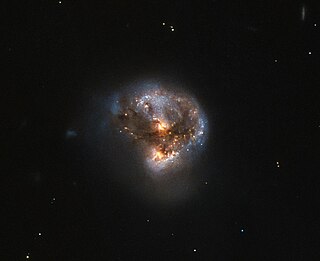
A megamaser is a type of astrophysical maser, which is a naturally occurring source of stimulated spectral line emission. Megamasers are distinguished from other astrophysical masers by their large isotropic luminosity. Megamasers have typical luminosities of 103 solar luminosities (L☉), which is 100 million times brighter than masers in the Milky Way, hence the prefix mega. Likewise, the term kilomaser is used to describe masers outside the Milky Way that have luminosities of order L☉, or thousands of times stronger than the average maser in the Milky Way, gigamaser is used to describe masers billions of times stronger than the average maser in the Milky Way, and extragalactic maser encompasses all masers found outside the Milky Way. Most known extragalactic masers are megamasers, and the majority of megamasers are hydroxyl (OH) megamasers, meaning the spectral line being amplified is one due to a transition in the hydroxyl molecule. There are known megamasers for three other molecules: water (H2O), formaldehyde (H2CO), and methine (CH).
Luminous infrared galaxies or LIRGs are galaxies with luminosities, the measurement of brightness, above 1011 L☉. They are also referred to as submillimeter galaxies (SMGs) through their normal method of detection. LIRGs are more abundant than starburst galaxies, Seyfert galaxies and quasi-stellar objects at comparable luminosity. Infrared galaxies emit more energy in the infrared than at all other wavelengths combined. A LIRG's luminosity is 100 billion times that of the Sun.

APM 08279+5255 is a very distant, broad absorption line quasar located in the constellation Lynx. It is magnified and split into multiple images by the gravitational lensing effect of a foreground galaxy through which its light passes. It appears to be a giant elliptical galaxy with a supermassive black hole and associated accretion disk. It possesses large regions of hot dust and molecular gas, as well as regions with starburst activity.
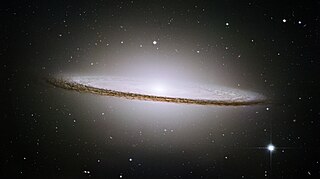
A low-ionization nuclear emission-line region (LINER) is a type of galactic nucleus that is defined by its spectral line emission. The spectra typically include line emission from weakly ionized or neutral atoms, such as O, O+, N+, and S+. Conversely, the spectral line emission from strongly ionized atoms, such as O++, Ne++, and He+, is relatively weak. The class of galactic nuclei was first identified by Timothy Heckman in the third of a series of papers on the spectra of galactic nuclei that were published in 1980.

NGC 4194, the Medusa merger, is a galaxy merger in the constellation Ursa Major about 128 million light-years (39.1 Mpc) away. It was discovered on April 2, 1791 by German-British astronomer William Herschel. Due to its disturbed appearance, it is object 160 in Halton Arp's 1966 Atlas of Peculiar Galaxies.

NGC 708 is an elliptical galaxy located 240 million light-years away in the constellation Andromeda and was discovered by astronomer William Herschel on September 21, 1786. It is classified as a cD galaxy and is the brightest member of Abell 262. NGC 708 is a weak FR I radio galaxy and is also classified as a type 2 Seyfert galaxy.
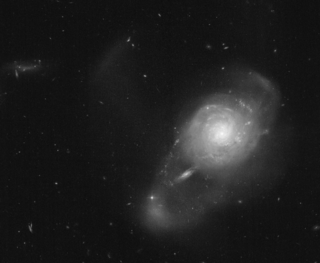
NGC 7679 is a lenticular galaxy with a peculiar morphology in the constellation Pisces. It is located at a distance of about 200 million light years from Earth, which, given its apparent dimensions, means that NGC 7679 is about 60,000 light years across. It was discovered by Heinrich d'Arrest on September 23, 1864. The total infrared luminosity is 1011.05 L☉, and thus it is categorised as a luminous infrared galaxy. NGC 7679 is both a starburst galaxy and a Seyfert galaxy.

Markarian 273 is a galaxy merger located in the constellation Ursa Major. It is located at a distance of about 500 million light years from Earth, which, given its apparent dimensions, means that Markarian 273 is about 130,000 light years across. It is an ultraluminous infrared galaxy and a Seyfert galaxy.
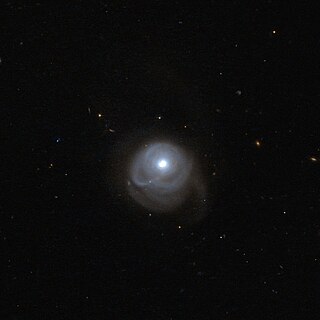
IRAS 05189-2524 is a galaxy merger located in the constellation Lepus. It is located 603 million light-years away from the Solar System and has an approximate diameter of 75,000 light-years.

IRAS F11119+3257 or simply as F11119+3257, is a galaxy located in constellation Ursa Major. With a redshift of 0.187580, it has a light travel time distance of 2.5 billion light-years and is considered an ultraluminous infrared galaxy (ULIRG).

IRAS 09104+4109 is a galaxy located in the constellation Lynx. With a redshift of 0.440797, the light travel time for this galaxy, corresponds to 4.8 billion light-years from Earth. It is the brightest cluster galaxy in MACS J0913.7+4056 galaxy cluster and classified as a hyperluminous infrared galaxy.
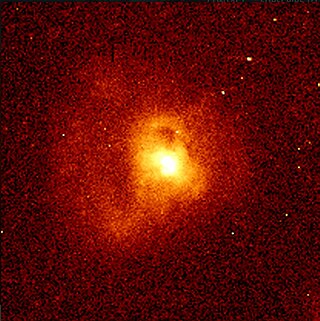
IRAS 13218+0552 known as SFRS 263, is a galaxy merger located in the Virgo constellation. Its redshift is 0.202806, putting the object at 2.6 billion light-years away from Earth. It is a Seyfert galaxy and a luminous infrared galaxy.

4C +72.26 known as NAME TX J1908+7220, is a radio galaxy located in the constellation Draco. At the redshift of 3.53, the galaxy is located roughly 11.5 billion light-years from Earth.

PKS 1345+125 known as PKS 1345+12 and 4C +12.50, is an ultraluminous infrared galaxy (ULIG) with an active galactic nucleus, located in the constellation Boötes. With a redshift of 0.121740, the galaxy is located 1.7 billion light-years from Earth.

Abell 1942 BCG, also known as PGC 1256558, is a massive elliptical galaxy of type-cD residing as the brightest cluster galaxy of the Abell 1942 galaxy cluster, located in the constellation Virgo. With a redshift of 0.224, the galaxy is located nearly 2.7 billion light-years away from Earth.

The South America Galaxy, also known as LEDA 69877 and IRAS 22491-1808, is a merging pair of ultraluminous infrared galaxies located in the constellation Aquarius. It is estimated to be 1.045 million light-years from the Milky Way and about 90,000 light-years in diameter. The object is moving away from the Solar System with a calculated radial velocity of approximately 23.300 kilometers per second.

IRAS 19254-7245, more commonly referred as the "Superantennae", are a pair of interacting galaxies located in the constellation of Pavo. It is located 820 million light years from Earth. It is an ultraluminous infrared galaxy and a Seyfert galaxy.

ESO 148-2 known as ESO 148-IG002 and IRAS 23128-5919, is a galaxy merger located in the constellation of Tucana. It is located 642 million light years from Earth and is classified a Wolf-Rayet galaxy as well as an ultraluminous infrared galaxy.

IRAS 07598+6508 known as IRAS F07599+6508, is a quasar located in the constellation of Camelopardalis. It is located 2.37 billion light years from Earth and is classified as both an ultraluminous infrared galaxy and a Seyfert galaxy.

IRAS 01003-2238 also known as IRAS F01004-2237 or simply F01004-2237, is a galaxy located in the constellation of Cetus. It is located 1.65 billion light years away from Earth and is a Seyfert galaxy and an ultraluminous infrared galaxy. IRAS 01003-2238 is also classified as a Wolf-Rayet galaxy, making the object one of the most distant known.



















